 |
||
|
||
| ||
IDF San Francisco: Intel Introduces VIIV Home Entertainment Platform IDF San Francisco: New Micro-architecture Will Suit All Platforms IDF San Francisco: Features Of New Micro-architecture IDF San Francisco: Tulsa, Bensley, Sossaman Server Solutions IDF San Francisco: The Future Of Personal Computers, Intel´s Version IDF San Francisco: Intel Introduces VIIV Home Entertainment Platform Early next year Intel is to be offering the VIIV home entertainment platform. 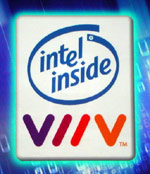 It will be the first Intel´s platform initially developed for digital homes. VIIV-based systems can feature usual desktop PC cases or stylized as consumer electronics devices. Speaking of capabilities, all VIIV-based machines will be shipped with remote controls, Microsoft Windows Media Center Edition and multimedia applications. 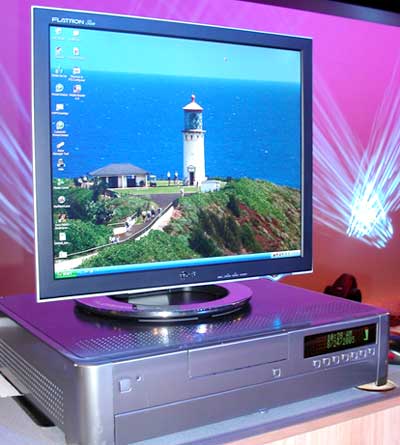 Another innovation is Intel Quick Resume that enables to quickly change PC modes (after initial boot-up). Some models will feature TV tuners. Moreover, each VIIV-based machine will feature 5.1ch or 7.1ch sound card to use the PC as a base of a home theatre. To simplify the deployment of such entertainment networks, which may consist of multimedia players, DVD players, TV sets, stereo systems, and other VIIV-certified devices, bundles will include special network configuration software. The first VIIV machines are expected in the market in Q1´2006. Source: Intel
IDF San Francisco: New Micro-architecture Will Suit All Platforms Intel´s new microarchitecture, of which we wrote in the previous news, will be used in all three platforms, including mobile, desktop and server. 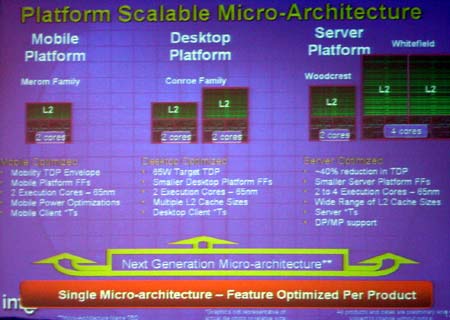 The mobile processors codenamed Merom will have two cores, lower TDP values, and optimized power consumption. Speaking of the desktop Conroe, it will also be dual-core, but since power consumption is not as important for desktop machines as it is for notebooks, their TDP is to be fixed at 65W. Besides, different models of Conroe will feature different amounts of L2 cache. At the same time, the compact design and low power consumption will allow for smaller PC dimentions. You can see an example of all this, the GoldenGate machine, in the hands of the speaker. 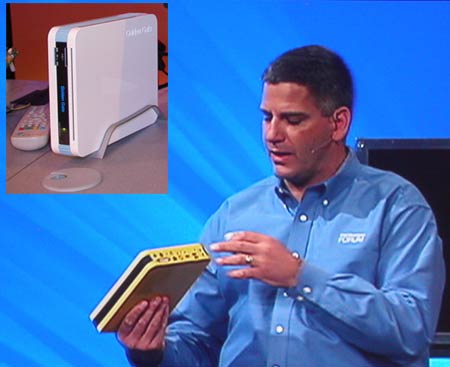 In the server segment we should expect about 40% TDP reduction, 2 or 4 cores and a wider gamma of L2 size and multi-way configurations. Speaking of manufacture, solutions for all segments will be made using 65nm process. As you already know, the transition to 65nm process is to be conducted noticeably faster than any transition before. This is illustrated in the upper left corner of the picture below.  Also on this picture is a list of production facilities capable of manufacturing 300mm wafers. Four existing fabs will be supported by Fab 12 in Arizona (before the year ends), Fab 24 on the Emerald Isle (early next year), and Fab 32 also in Arizona (in 2007). IDF San Francisco: Features Of New Micro-architecture Having taken a look at processors, let´s pay some attention to their micro-architecture as well: 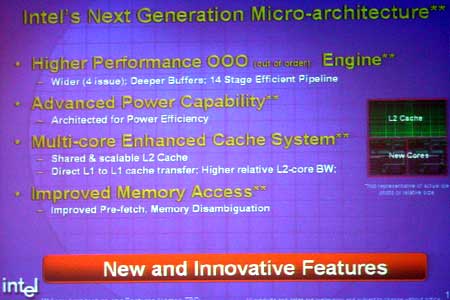 First, there´s a more powerful out-of-order engine featuring 4 channels, larger buffers and 14-stage pipeline. Then, there´s lower power consumption, of which we have already written. Third, the organization of L1 and L2 caches interaction in multi-core processors. In particular, direct data transfers between L1 caches of different cores. L2 cache will be shared and scalable. The bandwidth between L2 cache and core is to be increased. Finally, prefetch and memory disambiguation are to be honed as well. IDF San Francisco: Tulsa, Bensley, Sossaman Server Solutions Continuing our virtual journey around IDF San Francisco, let´s visit the server part of it. Obviously, dual-core technologies are of primary importance. In the spotlight — Tulsa, an enterprise multi-way platform to support Xeon MP, and Bensley, its "mainstream" dual-core alternative. Pat Gelsinger holds a wafer with exactly Tulsa chips in it. And a couple of words about the future Xeons, which are 65nm Sossaman expected after Paxville in 2006: Here´s how this roadmap looks like: Note that Paxville are actually to debut later this year. And, finally, below are unique photos of a Bensley-based motherboard with installed 32GB of Micron´s FB-DIMM: Some samples of the yet unannounced dual-core Xeon 5000 (Dempsey) and Woodcrest processors: A working system based on Sossaman CPU: IDF San Francisco: The Future Of Personal Computers, Intel´s Version At IDF San Francisco Intel introduced processor roadmaps for the desktop, mobile and server segments. On the picture below you can see some details about the first of them, i.e. personal computing.  In this segment Intel picks out two groups of users. The former includes demanding users and hardcore gamers as well as "common people" that use their PCs as entertainment hubs. According to Intel, all of them will be able to the same platform. Until Q1´2006 it should be Anchor Creek, Bridge Creek succeeding in Q2´2006. The difference is that demanding users will be offered 955X Express and 8xx/XE processors, while ordinary people should like 945G / 945P Express chipsets and 5xx, 6xx and 8xx processors more. In the future all of them are to move to Broadwater chipset and dual-core Presler processors, followed by Conroe. The second group gathers mobile users, whose demands are to be fulfilled by the Sonoma platform (915GM / 915PM Express chipsets, Pentium M 7xx CPUs; until the end of 2005). In early 2006 they should move to Napa (945GM, 945PM, 945GMS 955XM Express chipsets, single/dual core Yonah, followed by Merom). At IDF in San Francisco Intel introduced the Mote project. The idea of it is to create an intellectual self-organizing wireless network of miniature battery-powered devices equipped with radio transceivers — Motes. The platform is highly modular, requires very low power and has low cost of mass production. According to the developers, such networks of wireless sensors can be used everywhere, from agriculture to industry and military applications. Currently there are three vectors of development: further reduction of power consumption, higher levels of integration and higher reconfigurability. Each Mote bases on an XScale processor. According to the company, this enables battery life of 6-12 months. A Mote works under the Tiny OS that considers specifics of embedded systems with radio interfaces (Bluetooth, in particular). Speaking of pictures, on the first one you can see the first stage of this project. Early Motes were based on 8-bit controllers, had low memory and couldn´t provide high computational power or bandwidth. Their primary feature was low power consumption. 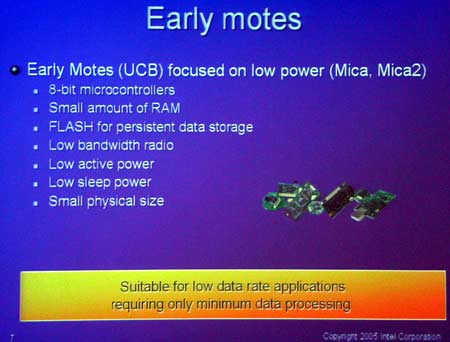 As one of the Mote application examples Intel introduced its own Fab: 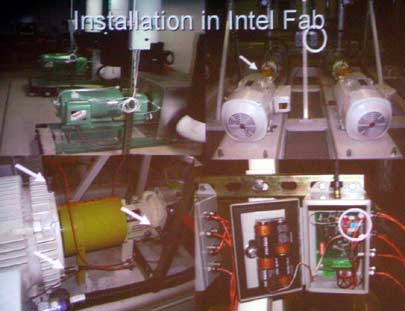 And the water supply system in Boston. 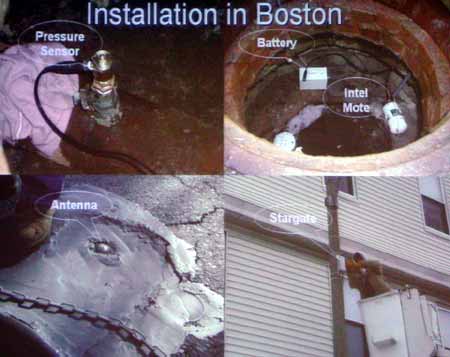 And this is how pipe control sensor communicates with a wireless hub. 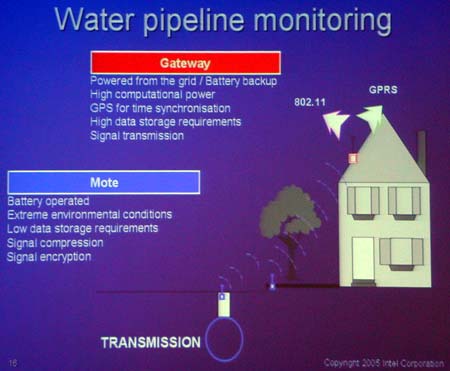 And this is how a network of Motes operates: 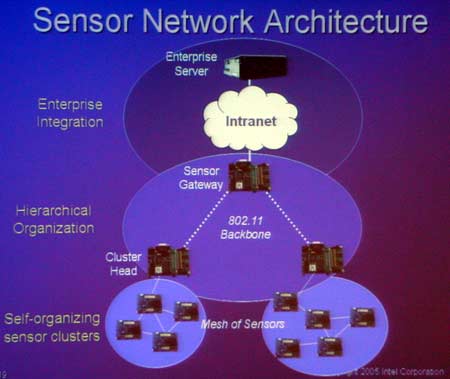 Mote2 is an advanced variant based on a 32-bit XScale PXA 271 processor. Works longer, emits farther, consumes less. 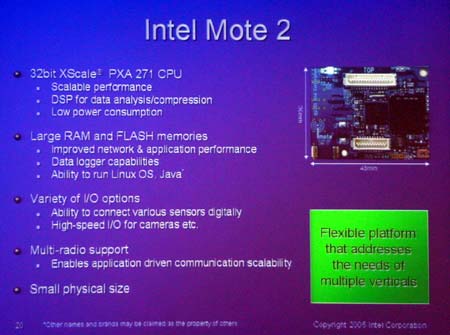 Various platform components. The closest to you is Mote2. 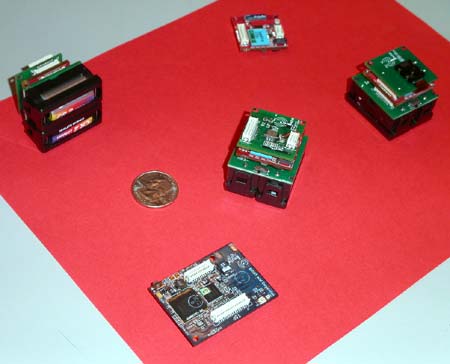 Mote2 in its glory: 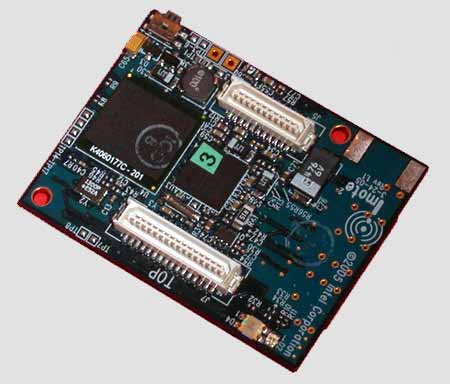 Source: Our reporter at IDF
Write a comment below. No registration needed!
|
Platform · Video · Multimedia · Mobile · Other || About us & Privacy policy · Twitter · Facebook Copyright © Byrds Research & Publishing, Ltd., 1997–2011. All rights reserved. |